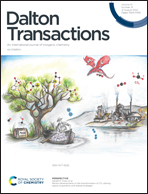Effect of the substituent on C–H activation catalyzed by a non-heme Fe(iv)O complex: a computational investigation of reactivity and hydrogen tunneling†
Abstract
Density functional theory investigations were performed to address the C–H activation reactivity and the influence of quantum mechanical tunneling catalyzed by a non-heme iron(IV)-oxo complex, namely [FeIVOdpaq-X]+, where the macrocyclic ligand dpaq represents {2-[bis(pyridine-2-yl-methyl)]amino-N-quinolin-8-yl-acetamido}. Counter ion and solvent corrections were incorporated in the computation to avoid self-interaction error. To find the impact of the indirectly linked substituents to the central metal atom, Fe, the macrocyclic ligand dpaq was substituted at the 5-position of its quinoline moiety represented as dpaq-X and the reactivity and hydrogen tunneling were compared with the parent ligand dpaq-H. Here, both electron-donating, e.g. –N(CH3)2 and –OMe, and electron-withdrawing, e.g. –NO2 and –SO2CF3, substituents compared to hydrogen were considered. The reactions displayed exchange interaction favouring two-state reactivity (TSR) as the S = 2 state was found for the excited state in the reactant, which crossed the S = 1 path (initially the ground state) during the progress of the reaction. This was further verified by the tunneling corrected kinetic isotope effect (KIE), which closely matched with the experiment (32) in the S = 2 state (22), whereas the S = 1 KIE (∼69) was found to be very far from that experimentally observed. More than 90% of all the C–H activation reactions proceeded through quantum mechanical tunneling even at room temperature. As the substituent group became more electron-donating, both the tunneling contributions and the kinetic isotope effect increased, which supported the anti-electrophilic tunneling control reactivity premise. The presented consequences may further expose the possibility for the rational design of metal-based catalysts with systematic ligand/substituent tuning that can be performed efficiently through quantum mechanical tunneling.



 Please wait while we load your content...
Please wait while we load your content...